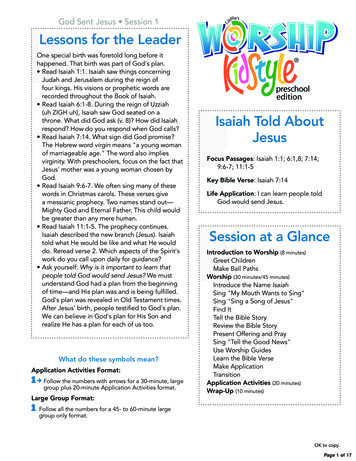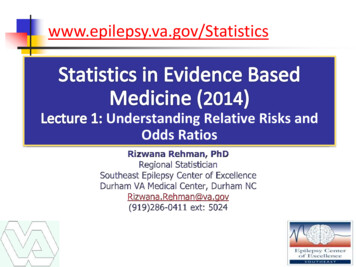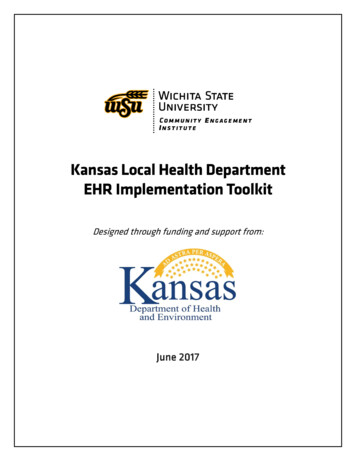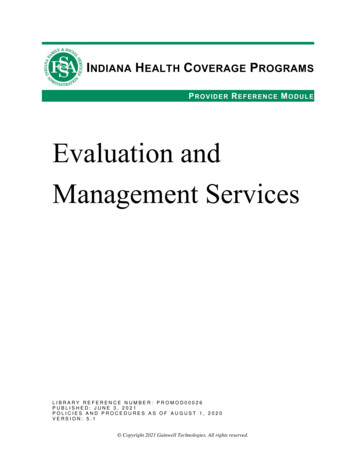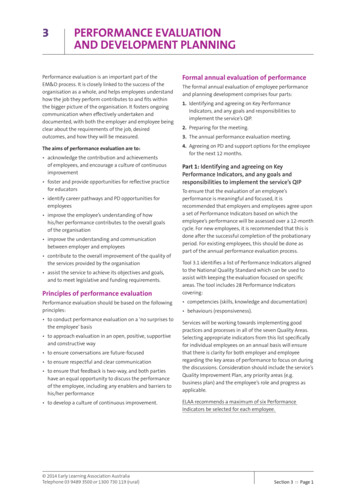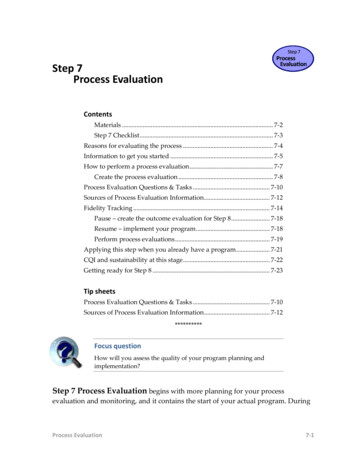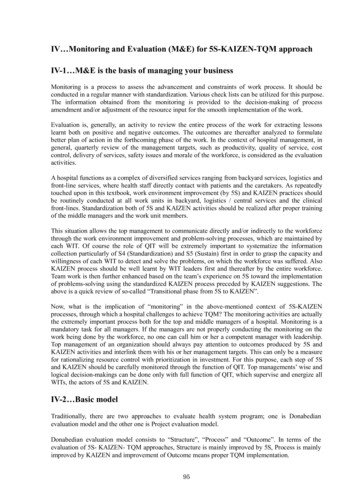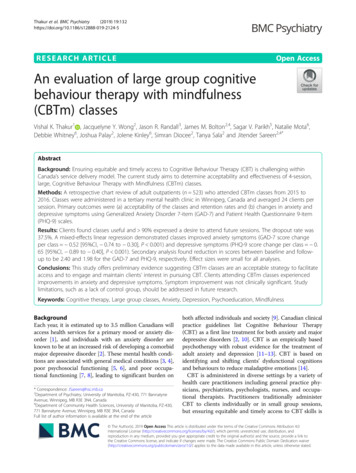
Transcription
Thakur et al. BMC Psychiatry(2019) EARCH ARTICLEOpen AccessAn evaluation of large group cognitivebehaviour therapy with mindfulness(CBTm) classesVishal K. Thakur1 , Jacquelyne Y. Wong2, Jason R. Randall3, James M. Bolton2,4, Sagar V. Parikh5, Natalie Mota6,Debbie Whitney6, Joshua Palay2, Jolene Kinley6, Simran Diocee2, Tanya Sala2 and Jitender Sareen2,4*AbstractBackground: Ensuring equitable and timely access to Cognitive Behaviour Therapy (CBT) is challenging withinCanada’s service delivery model. The current study aims to determine acceptability and effectiveness of 4-session,large, Cognitive Behaviour Therapy with Mindfulness (CBTm) classes.Methods: A retrospective chart review of adult outpatients (n 523) who attended CBTm classes from 2015 to2016. Classes were administered in a tertiary mental health clinic in Winnipeg, Canada and averaged 24 clients persession. Primary outcomes were (a) acceptability of the classes and retention rates and (b) changes in anxiety anddepressive symptoms using Generalized Anxiety Disorder 7-item (GAD-7) and Patient Health Questionnaire 9-item(PHQ-9) scales.Results: Clients found classes useful and 90% expressed a desire to attend future sessions. The dropout rate was37.5%. A mixed-effects linear regression demonstrated classes improved anxiety symptoms (GAD-7 score changeper class 0.52 [95%CI, 0.74 to 0.30], P 0.001) and depressive symptoms (PHQ-9 score change per class 0.65 [95%CI, 0.89 to 0.40], P 0.001). Secondary analysis found reduction in scores between baseline and followup to be 2.40 and 1.98 for the GAD-7 and PHQ-9, respectively. Effect sizes were small for all analyses.Conclusions: This study offers preliminary evidence suggesting CBTm classes are an acceptable strategy to facilitateaccess and to engage and maintain clients’ interest in pursuing CBT. Clients attending CBTm classes experiencedimprovements in anxiety and depressive symptoms. Symptom improvement was not clinically significant. Studylimitations, such as a lack of control group, should be addressed in future research.Keywords: Cognitive therapy, Large group classes, Anxiety, Depression, Psychoeducation, MindfulnessBackgroundEach year, it is estimated up to 3.5 million Canadians willaccess health services for a primary mood or anxiety disorder [1], and individuals with an anxiety disorder areknown to be at an increased risk of developing a comorbidmajor depressive disorder [2]. These mental health conditions are associated with general medical conditions [3, 4],poor psychosocial functioning [5, 6], and poor occupational functioning [7, 8], leading to significant burden on* Correspondence: JSareen@hsc.mb.ca2Department of Psychiatry, University of Manitoba, PZ-430, 771 BannatyneAvenue, Winnipeg, MB R3E 3N4, Canada4Department of Community Health Sciences, University of Manitoba, PZ-430,771 Bannatyne Avenue, Winnipeg, MB R3E 3N4, CanadaFull list of author information is available at the end of the articleboth affected individuals and society [9]. Canadian clinicalpractice guidelines list Cognitive Behaviour Therapy(CBT) as a first line treatment for both anxiety and majordepressive disorders [2, 10]. CBT is an empirically basedpsychotherapy with robust evidence for the treatment ofadult anxiety and depression [11–13]. CBT is based onidentifying and shifting clients’ dysfunctional cognitionsand behaviours to reduce maladaptive emotions [14].CBT is administered in diverse settings by a variety ofhealth care practitioners including general practice physicians, psychiatrists, psychologists, nurses, and occupational therapists. Practitioners traditionally administerCBT to clients individually or in small group sessions,but ensuring equitable and timely access to CBT skills is The Author(s). 2019 Open Access This article is distributed under the terms of the Creative Commons Attribution 4.0International License (http://creativecommons.org/licenses/by/4.0/), which permits unrestricted use, distribution, andreproduction in any medium, provided you give appropriate credit to the original author(s) and the source, provide a link tothe Creative Commons license, and indicate if changes were made. The Creative Commons Public Domain Dedication o/1.0/) applies to the data made available in this article, unless otherwise stated.
Thakur et al. BMC Psychiatry(2019) 19:132challenging within this delivery model [15]. Poor accessto treatment is a major issue precluding effective publichealth initiatives in anxiety and depression management,with a substantial proportion of individuals not receivingtreatment despite a perceived need [16, 17]. Offeringbrief, low-intensity CBT within a stepped care model isone strategy aimed at improving CBT access in Canada[18]. Examples include self-help books, website basedtherapies, and, of particular interest to our study, largepsychoeducational groups [19]. Administering CBT in alarge-group is a promising solution which enables clinicians to reach a large number of clients.Large-group CBT was introduced at a tertiary care clinicin Winnipeg, Canada in 2014 to manage the problem ofpersistently long wait times. These transdiagnostic2-session CBT classes were rated useful by clients, led tomodest improvements in anxiety symptoms, and reducedwait-times from approximately one year to three months[20]. Given these promising findings and client feedback,the CBT classes were expanded to 4 sessions and introduced mindfulness within the core content. These 4session transdiagnostic Cognitive Behaviour Therapy withMindfulness (CBTm) classes were independently developed and administered at the clinic to introduce clients toCBT principles, basic mindfulness strategies, and toprovide various self-help resources at a time where theyotherwise may not have had access to therapy.Mindfulness is the process of being nonjudgmentallyaware of the present moment, including one’s thoughts, sensations and environment, while encouraging inquisitiveness,open observation, and acceptance [21, 22].Evidence suggestsmindfulness-based interventions, such as mindfulness-basedcognitive therapy (MBCT) and mindfulness-based stressreduction (MBSR), are effective in treating anxiety and depression [22, 23]. Mindfulness, as it is taught in these interventions and in the CBTm classes, is intended to reduceidentification with thoughts and feelings by cultivating anawareness of the impermanence (arising, passing and changing) of these mind productions. There is accumulatingevidence that mindfulness meditation, with the goal of calmattentiveness and acceptance, down-regulates mental activitywithin the default mode network (DMN). DMN activation isassociated with mind wandering, negative affect and rumination as experienced by those with anxiety or depression[24]. Other work shows that mindfulness may improvecognitive flexibility, working memory capacity, goal directedbehaviour, and emotional regulation, as one’s attention andcognitive resources are shifted away from dysfunctionalthoughts and emotions [25]. Moreover, these complex functions may be modulated by neural networks, whose resources can be constrained by negative emotions and mindwandering; meditation allows for a more flexible allocationof these limited resources, such that they may be availablefor other, more salutary, cortical functions [24].Page 2 of 10To our knowledge, there is no research on brief, lowintensity, large group CBT interventions which incorporate mindfulness in the literature. Thus, the current studysought to evaluate the 4-session CBTm class intervention in a Canadian population. We conducted a retrospective chart review of clients who attended classesbetween 2015 and 2016. The two primary outcomeswere: (a) acceptability and retention rates of CBTmclasses and (b) clients’ change in anxiety and depressivesymptoms as a result of attending CBTm classes. RecentUK studies demonstrated similar large-group CBT interventions are efficient, well tolerated, and effective intreating symptoms of anxiety and depression [26–28].Thus, we hypothesized the CBTm classes would replicate these findings by being acceptable, both in terms ofclient feedback and retention rates, and lead to improvements in anxiety and depressive symptoms.MethodsParticipantsClients who attended at least one CBTm class betweenJanuary 2015 and December 2016. Clients were referredby general practice physicians to a centralized intake service within a tertiary care hospital in Winnipeg, Canada.From there, clients were referred to an outpatient mental health clinic for further assessment by a psychiatrist,psychiatry resident, or nurse therapist (referrals began inNovember 2014). A mental health diagnosis was eitherconfirmed or established during this interview by theclinician, although no standardized diagnostic tools wereused. The presence of a mental health diagnosis and being 18 years of age were the only specific inclusion criteria required to be eligible for the classes. Exclusioncriteria for the classes include being 18 years of age,the presence of active psychosis or mania, acutely elevated suicide risk, or severe cognitive impairment. It wasdeemed these factors would potentially prevent an individual from adequately concentrating and absorbing theclass content. Alternative treatments were offered to ineligible clients as clinically indicated Fig. 1.InterventionClasses were 90 min in length and ranged in sizefrom 10 to 41 clients (M 24, SD 7) per session,not including clients’ partners, family members, orfriends who were encouraged to attend. Sessions wereled and facilitated by two staff psychiatrists. One facilitator received certification from the Academy ofCognitive Therapy in 2004 and received the BeckScholar Award in 2013. The other facilitator completed a 5-day in-person training course on CoreConcepts in CBT at the Beck Institute in 2009, aswell as 8 h of online training on Integrating CBT andMindfulness through the Beck Institute’s online
Thakur et al. BMC Psychiatry(2019) 19:132Page 3 of 10Fig. 1 Flow of Participants Through Outpatient Mental Health Clinic. †Reasons for participants not attending include meeting exclusion criteria orpersonal reasons for not attending. ‡Participants included in data analysis had to complete at least one measure in one CBTm class from Jan2015-Dec 2016. CBT, Cognitive Behaviour Therapy; CBTm, Cognitive Behaviour Therapy with Mindfulnesstraining program. Neither facilitator received specifictraining in MBSR or MBCT. Occasionally other facilitators, such as medical students and residents,assisted in running the classes. There was minimalinteraction between facilitators and clients, with interactions often limited to discussions of homework andanswering clients’ questions or concerns. In terms ofhomework, clients were encouraged to practice mindfulness meditation for five minutes, twice per day,and to partake in at least two other activities broughtup in class. These homework activities included, butwere not limited to, accessing self-help websites, setting goals, thought records, mood tracking, and physical exercise such as attending a yoga class. Unlikeformal CBT programs, there were no individuallytailored activities or specific feedback given to clientsas they were progressing through homework activitiesand applying CBT skills. Class content was structuredas follows: Class 1: introduction and outline of the course, rulesand expectations, self-help resources, mindfulness
Thakur et al. BMC Psychiatry(2019) 19:132exercise, introduction to the cognitive behaviouralframework, cognitive distortions, thought records,and homework. Class 2: mindfulness exercise, review of homework,basics of behaviour therapy, exposure therapy, goalsetting, and homework. Class 3: mindfulness exercise, review of homework,discussion of healthy living, sleep hygiene, andhomework. Class 4: mindfulness exercise, review of homework,anger management strategies, assertiveness training,self-compassion, problem solving, and homework.The four mindfulness meditations used in the CBTmclasses were derived from those taught within mindfulness-based stress reduction (MBSR) [29] which is a transdiagnostic intervention proven useful with stress, depression,and anxiety management [30–32]. Specifically, the meditations were body scan, awareness of the breath, awarenessof the five senses and loving-kindness. These were introduced in the same order as followed within MBSR. Clientswere encouraged to download the no-cost app, MindShift,which has recorded instructions for both body scan andawareness of breath. They could also seek out recordedinstructions for the other meditations but no specific direction was given for this.Following completion of 4 classes, clients were welcome to repeat classes as booster sessions or proceed toconventional CBT group therapy if more intensive treatment was required. Verbal or written consent from eachclient was not required to perform the chart review. Acorresponding website (cbtm.ca) was also developed inwhich class materials and handouts could be accessedfor free.ProcedureThe sample was derived from a retrospective chart reviewwith approval from the University of Manitoba HumanResearch Ethics Board (H2015:137) and Research ImpactCommittee (R12015:048). Measures were completed byevery client on a session-to-session basis, immediatelyafter each session, as part of routine monitoring of clinicalprogress. ‘Sessions’ included the initial intake assessmentat the clinic, each CBTm class, and each small group CBTsession following the classes (if applicable). The intakeassessment served as the baseline and each subsequentclass attended in chronological order, regardless of intervention cycle, served as an individual time-point (up to amaximum of 4). The measures completed immediately before the first small group CBT session served as the study’sfollow-up. Classes were held weekly, with only slight variation due to clinician availability or holidays. The meanduration between the intake assessment and the firstattended CBTm class was 4 weeks and the median was 2Page 4 of 10weeks. The mean duration between the last attended classand follow-up was 12 weeks and the median was 9 weeks.MeasuresSociodemographic factors and dropoutSociodemographic factors of interest (age, sex, marital status, education and employment) were obtained from aself-report questionnaire found in clients’ medical charts.Clients completed this questionnaire on the day of theirintake assessment at the clinic. The primary mental healthdiagnosis was also obtained from clients’ medical charts,either through the CBTm class assessment form or otherrelevant notes and assessments completed at the intakeassessment. Dropout data was obtained using class attendance forms completed at every class.Acceptability and baseline predictors of class completionClients’ self-reported acceptability of the CBTm classeswas assessed using two items from the evaluation formthey completed immediately after each session. The firstitem asks the respondent how useful they find the sessionand is rated on a 5-point Likert scale ranging between“1 Not very useful” and “5 Extremely useful”. The second item is a dichotomous Yes/No question asking therespondent if they would attend another session like theone they just attended. These two items were chosen asthey are easy to report and are completed by most clients.Remaining items on the evaluation form were not chosenfor this study as they were often left blank by clients; thesethree qualitative items ask the respondent to [1] list threethings they learned [2] describe what they like about thesession and [3] describe what could be improved. Futurestudies may wish to use formal measures of satisfaction asthese were not implemented in the current study. Generalized Anxiety Disorder 7-item (GAD-7) score, PatientHealth Questionnaire 9-item (PHQ-9) score, sex, education, and mental health diagnoses at the time of intakeassessment were the baseline variables of interest in predicting completion of 4 or more classes.Anxiety and depressive symptomsThe Generalized Anxiety Disorder 7-item (GAD-7) scale[33] and the Patient Health Questionnaire 9-item (PHQ9) scale [34] were used to assess changes in anxiety anddepressive symptoms, respectively. Both scales ask the respondent to reflect on how often they have been botheredby their symptoms over the past 2 weeks and rate itemson a 4-point Likert scale ranging between 0 “Not at all”and 3 “Nearly every day”. A large body of literature showsthe GAD-7 and PHQ-9 have good test-retest reliabilityand validity in measuring symptom severity in the generalpopulation [33–36]. These scales are also useful in monitoring symptom change across time [33, 35, 37].
Thakur et al. BMC Psychiatry(2019) 19:132We used two separate methods to assess whether clients experienced clinically significant improvements insymptoms with the CBTm intervention. The first wasbased on McMillan et al.’s recommendations [38]. Theirdefinition of clinically significant change comprised ofthree components; applied to anxiety they are: (a) meanGAD-7 score at follow-up 8 [33] (b) improvementgreater than, or equal to, the minimum clinically important difference (MCID), and (c) at least medium effectsizes ( 0.50). Applied to depression they are: (a) meanPHQ-9 score at follow-up 10 [34] (b) improvementgreater than, or equal to, the MCID, and (c) at leastmedium effect sizes ( 0.50). The MCID noted above isthe smallest difference in score considered to be clinically important, and was determined to be 5 in our studyfor both the GAD-7 and PHQ-9 using Lowe et al.’smethodology [37]. According to this methodology, theMCID for a measure can be estimated using the following calculation (r reliability coefficient): pffiffiffiffiffiffiffiffi MCID ¼ 1:96 SDbaseline 1 rAnother method to calculate clinically significantchange was applied to the GAD-7 and PHQ-9 in ourstudy [39]. According to this methodology, one cancompare the mean score and standard deviation of aclinical population with that of a referential “normal”population to determine the extent to which changeafter treatment is clinically meaningful. We comparedthe scores from our sample to healthy samples fromother studies [33, 34]. The calculation is:ðMeanclin SDnorm Þ þ ðMeannorm SDclin ÞSDnorm þ SDclinUsing this calculation, one would expect clinically significant change if the GAD-7 score change is 6.52 foranxiety, and if the PHQ-9 score change is 7.60 fordepression.Analytic strategyStatistical analysis was performed using SPSS (version24) and STATA (version 13.1). Adjusted odds ratios werecalculated using a logistic regression model to assessbaseline predictors of class completion. The variables ofinterest were regressed against a binary variable indicating completion of at least 4 classes. Descriptive statisticswere also obtained for the sample.The independent variable was the number of CBTmclasses attended by a subject and the dependent variablewas the score on the GAD-7 and PHQ-9. Primary analysis used a mixed-effects linear regression model to estimate the effect of the number of classes on the outcomemeasures. The model allowed the data to be analyzed asa within-subject design to examine the change in scoresPage 5 of 10across repeated outcome measures in the same subject(up to six time-points were clustered within individual).The individual level was the only level in the model asclients could not be clustered by groups or treatmentsetting given the data available. Maximum likelihood estimation was used in this model. The fixed effects werethe number of classes (a continuous variable), the effectof the gap between baseline and the first attended class(a binary dummy variable coded 1 after the gap has occurred), and the effect of the gap between the lastattended class and follow-up (a binary dummy variablecoded 1 starting with follow-up) on GAD-7 and PHQ-9scores. The random effects examine the difference between individuals with respect to their baseline scoreand the changes over time. Other variables (sex, education, and mental health diagnoses) were not included oradjusted for in this analysis as they did not vary withinindividuals. Effect sizes (Cohen’s d) of the regressionmodel estimates were also obtained using the baselinestandard deviation.Secondary analysis calculated the mean differences inoutcome measure scores between baseline and follow-up.Percent reductions in symptoms were calculated using themean difference in outcome measure scores as the dividend and the mean baseline score as the divisor. Effectsizes (Cohen’s d) of the mean differences were alsoobtained.ResultsSociodemographic factors and dropoutOf the 655 clients assessed for eligibility for the CBTmclasses from November 2014 to December 2016, 533attended at least one class (10 of these clients did not fillout any measures and were not included in analysis).The 122 clients who did not attend any class eitherchose not to for personal reasons or met exclusion criteria. Limited dropout information precludes us fromproviding further detail. Among those who attended,333 (62.5%) completed 4 or more classes and 200(37.5%) dropped out. We define dropout as completingless than 4 classes, regardless of reason for dropout. Themean and median number of classes attended by thissample were 3.5 (SD 1.7) and 4 (IQR 2 to 4), respectively. 179 clients (53.8% of those eligible) moved on toreceive small group CBT. The mean age of the analyzedsample was 39.3 (SD 13.8), and more than half were female (58.9%). There were a broad range of primary mental health diagnoses which are reported in Table 1.Acceptability and baseline predictors of class completionMean scores on the usefulness item ranged between 3.9and 4.1 (SD range 0.80 to 0.89). The proportion of clients who indicated they would attend another sessionwas consistently over 90%, with a range of 94 to 99%,
Thakur et al. BMC Psychiatry(2019) 19:132Page 6 of 10Table 1 Sociodemographic Characteristics at Intake Assessment(n 523)VariableAgeYears, mean (SD)39.3 (13.8)Sex, n (%)Male178 (34.0)Female308 (58.9)Unknowna37 (7.1)Marital Status, n (%)Married or common law180 (34.4)Separated, divorced, or widowed58 (11.1)Never married237 (45.3)Unknowna48 (9.2)Education, n (%)No high school graduation56 (10.7)High school graduation117 (22.4)Some postsecondary107 (20.5)Trade, college, or university certificate or diploma47 (9.0)University Degree116 (22.1)Unknowna80 (15.3)Employment, n (%)Paid employment or retired251 (48.0)Unemployed160 (30.6)Student28 (5.4)Unknowna84 (16.1)Primary mental health diagnosis, n (%)Major Depressive Disorder137 (26.2)Generalized Anxiety Disorder101 (19.3)Social Anxiety Disorder43 (8.2)Obsessive Compulsive Disorder34 (6.5)Persistent Depressive Disorder32 (6.1)Posttraumatic Stress Disorder31 (5.9)Panic Disorder24 (4.6)Bipolar Disorder24 (4.6)Anxiety Not Otherwise Specified19 (3.6)Depression Not Otherwise Specified18 (3.4)Otherb60 (11.5)aRespondent failed to complete item. bIncludes specific phobia, postschizophrenic depression, postpartum depression, alcohol and substance usedisorders, eating disorders, personality disorders, somatic symptom disorders,neurodevelopmental disorders, cognitive disordersdepending on the session. Two significant baseline predictors of CBTm class completion were found. First, clients with a higher baseline score on the PHQ-9 weresignificantly less likely to complete 4 classes (OR 0.95[95%CI 0.91 to 0.99], p 0.05). Second, clients who didnot complete high school (did not graduate and/orreceive diploma) were also significantly less likely tocomplete 4 classes (OR 0.39 [95%CI 0.20 to 0.75], p 0.05). All other baseline variables did not significantly predict class completion: GAD-7 score (p 0.93), sex (p 0.92), mental health diagnosis (p 0.37).Anxiety symptomsThe mean baseline score for anxiety symptom severitywas GAD-7 12.6 (SD 5.8). The mixed-effects linearregression indicated a statistically significant decline insymptoms of anxiety when attending CBTm classes(mean GAD-7 score change per class 0.52 [95%CI, 0.74 to 0.30], p 0.001). There was significant variationin effect across individuals based on the regressionmodel. The Cohen’s effect size for this analysis was d 0.36, a small effect [40]. The regression model controlledfor the significant decline in symptoms between baselineand the first class, and the non-significant increase insymptoms between class 4 and follow-up (Table 2).The mean change in the GAD-7 score between baselineand follow-up was 2.40 (95%CI, 3.38 to 1.41) – an18% (95%CI, 9–24%) reduction in anxiety symptoms(Table 3). The Cohen’s effect size for this analysis was d 0.41, a small effect. These results were not clinically significant according to Mcmillan et al.’s definition [38]. Specifically, we calculated (a) the post-treatment GAD-7score of 10.2 was greater than the cutoff of 8 (b) the improvement of 2.40 did not meet the MCID of 5 which wascalculated and (c) the effect size of 0.41 was less than thethreshold of 0.50. These findings were also not clinicallysignificant according to Evans et al.’s definition [39]. Specifically, the GAD-7 score improvement of 2.40 did notmeet the calculated value of 6.52.Depressive symptomsThe mean baseline score for depression symptom severity was PHQ-9 15.2 (SD 6.8). The mixed-effectsTable 2 Mean Changes in Outcome Measure Scores UsingMixed-Effects Linear RegressionOutcome MeasurePhase of TherapyMean Changed (95% CI)GAD-7Intake Assessmenta 0.98** ( 1.58 to 0.38)CBTm Classesb 0.52** ( 0.74 to 0.30)cPHQ-9Treatment Gap0.79 ( 0.13 to 1.71)Intake Assessment† 0.82* ( 1.51 to 0.13)CBTm Classes 0.65** ( 0.89 to 0.40)Treatment Gap§1.40* (0.43 to 2.36)baTime between intake assessment (baseline) and CBTm Class 1. bEffect ofCBTm classes alone. Controlled for time between baseline and CBTm class 1and treatment gap between CBTm class 4 and first small group CBT session(follow-up). cReflects time between CBTm class 4 and follow-up. dFor CBTmclasses, reflects mean change per CBTm class attendedCBTm Cognitive Behaviour Therapy with Mindfulness, GAD-7 GeneralizedAnxiety Disorder 7-item scale, PHQ-9 Patient Health Questionnaire 9-item scale**P 0.001. *P 0.05
Thakur et al. BMC Psychiatry(2019) 19:132Page 7 of 10Table 3 Mean Changes and Percent Reduction in Outcome Measure Scores between Baseline and Follow-upaOutcome MeasureMean Change (95% CI)Percent Reduction, % (95% CI)GAD-7 2.40 ( 3.38 to 1.41)18 (9 to 24)PHQ-9 1.98 ( 3.13 to 0.83)13 (3 to 18)aIntake assessment served as study baseline. First small group CBT session served as study follow-upGAD-7 Generalized Anxiety Disorder 7-item scale, PHQ-9 Patient Health Questionnaire 9-item scalelinear regression indicated a statistically significant decline in symptoms of depression when attending CBTmclasses (mean PHQ-9 score change per class 0.65[95%CI, 0.89 to 0.40], p 0.001). There was significant variation in effect across individuals based on theregression model. The Cohen’s effect size for this analysis was d 0.38, a small effect [40]. The regressionmodel controlled for the significant decline in symptomsbetween baseline and the first class, and the significantincrease in symptoms between class 4 and follow-up(Table 2).The mean change in the PHQ-9 score between baseline and follow-up was 1.98 (95%CI, 3.13 to 0.83) –a 13% (95%CI, 3–18%) reduction in depressive symptoms (Table 3). The Cohen’s effect size for this analysiswas d 0.29, a small effect. These results were not clinically significant according to Mcmillan et al.’s definition[38]. Specifically, we calculated (a) the post-treatmentPHQ-9 score of 13.2 was greater than the cutoff of 10(b) the improvement of 1.98 did not meet the MCID of5 which was calculated and (c) the effect size of 0.29 wasless than the threshold of 0.50. These findings were alsonot clinically significant according to Evans et al.’s definition [39]. Specifically, the PHQ-9 score improvement of1.98 did not meet the calculated value of 7.60.DiscussionThe current study demonstrates that a 4-session, large,Cognitive Behaviour Therapy with Mindfulness (CBTm)class intervention is acceptable and may be associatedwith an improvement in anxiety and depressive symptoms. To our knowledge, this is the first study to investigate a brief, low intensity, large group CBT interventionwhich incorporates mindfulness. Our findings expandupon previous work from our group which found largegroup CBT classes were useful, led to modest improvements in anxiety symptoms, and reduced wait times forconventional CBT group therapy [20].Our first hypothesis that the CBTm classes would be acceptable, both in terms of client feedback and retentionrates, was supported by the results. Clients reported theyfound the classes useful and a significant proportion (over90%) indicated they would attend another session. Thesefindings remained stable through the 4 sessions, suggesting the classes are a viable strategy to facilitate CBT accessand to engage and maintain the interest of a large numberof clients. Successful engagement is a key advantage of thisservice delivery model as traditional CBT delivery oftenfails to provide clients with equitable and timely access toCBT skills at their time of most need. The CBTm classeshad a dropout rate of 37.5%, which is consistent with similar large group CBT interventions found in the literature[26–28]. More than half (53.8%) of eligible clients (thosethat completed the 4-session intervention) moved on toconventional small group CBT therapy. Future researchshould investigate long-term dropout rates and specificreasons for dropout as these were not assessed in thisstudy.Our second hypothesis that clients would experienceimprovements in anxiety and depressive symp
Mindfulness is the process of being nonjudgmentally aware of the present moment, including one 's thoughts, sen-sations and environment, while encouraging inquisitiveness, open observation, and acceptance [ 21, 22].Evidence suggests mindfulness-based interventions, such as mindfulness-based cognitive therapy (MBCT) and mindfulness-based stress




